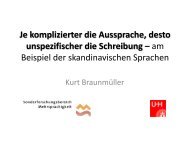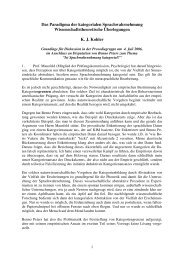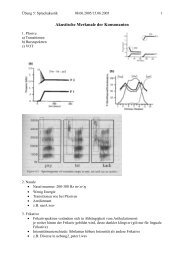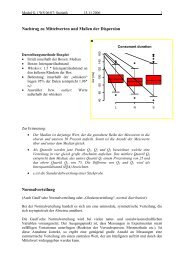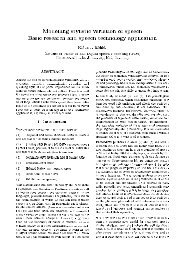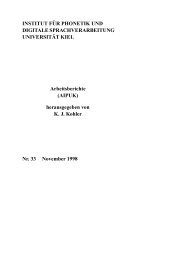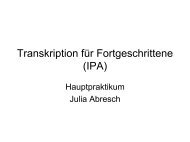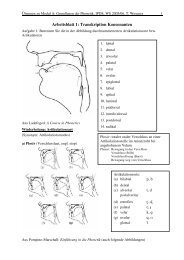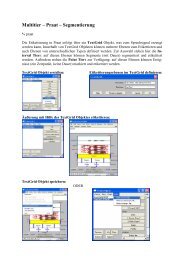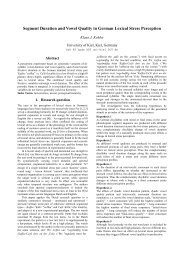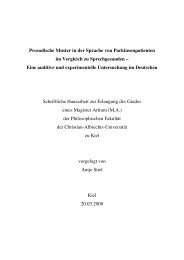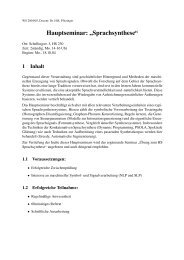Schwa deletion in German read and spontaneous speech
Schwa deletion in German read and spontaneous speech
Schwa deletion in German read and spontaneous speech
Create successful ePaper yourself
Turn your PDF publications into a flip-book with our unique Google optimized e-Paper software.
<strong>Schwa</strong> <strong>deletion</strong><br />
<strong>in</strong> <strong>German</strong> <strong>read</strong> <strong>and</strong> <strong>spontaneous</strong> <strong>speech</strong><br />
1 Introduction<br />
Klaus J. Kohler<br />
Jonathan Rodgers<br />
December 9th 2000<br />
1.1 <strong>Schwa</strong> <strong>deletion</strong> as a Connected Speech phenomenon<br />
Connected <strong>speech</strong> phenomena have traditionally been an object of <strong>in</strong>vestigation at<br />
Kiel (Kohler 1996), so much so that the first research project after the I.P.D.S. was<br />
founded <strong>in</strong> 1971 addressed the phonetic pattern<strong>in</strong>g of connected <strong>speech</strong> above the<br />
word level (Kohler 1973). In the same tradition, the more recent gather<strong>in</strong>g <strong>and</strong><br />
publication of a segmentally <strong>and</strong> prosodically labelled corpus of <strong>read</strong> <strong>and</strong> <strong>spontaneous</strong><br />
<strong>speech</strong> (IPDS 1994, 1995, 1996, 1997a) makes it possible to re-exam<strong>in</strong>e<br />
issues addressed by Kohler et al. (1973) <strong>and</strong> Gnutzman (1975) <strong>in</strong> the light of more<br />
natural <strong>speech</strong> data than were previously available.<br />
Vowel reduction <strong>and</strong> <strong>deletion</strong>, <strong>and</strong> <strong>in</strong> particular <strong>deletion</strong> of schwa, play a pivotal<br />
role <strong>in</strong> other reduction phenomena. Kohler (1990) po<strong>in</strong>ts out that <strong>in</strong> a series<br />
of processes that derive reduced realizations from canonical forms, it is either<br />
a precondition or <strong>in</strong>termediate stage, <strong>and</strong> he provides Generative Phonologytype<br />
rewrite-rules (Chomsky <strong>and</strong> Halle 1968) to specify processes such as /r/vocalization,<br />
weak forms, elisions <strong>and</strong> assimilations.<br />
Our study of schwa <strong>deletion</strong> <strong>in</strong> <strong>spontaneous</strong> <strong>and</strong> <strong>read</strong> <strong>speech</strong> complements the<br />
exam<strong>in</strong>ation of vowel <strong>deletion</strong>s <strong>in</strong> <strong>spontaneous</strong> <strong>speech</strong> by Helgason <strong>and</strong> Kohler<br />
(1996), which largely excluded schwa. They focused on vowels other than schwa<br />
for quantitative <strong>and</strong> qualitative reasons: schwa is deleted far more frequently than<br />
other vowels, but at the same time the reductions <strong>in</strong> which schwa <strong>deletion</strong> is a part<br />
rarely reta<strong>in</strong> the residual articulations (captured by the MA label) that characterize<br />
many other vowel <strong>deletion</strong>s (Helgason <strong>and</strong> Kohler 1996:121). The overview offered<br />
<strong>in</strong> that study is brought up to date <strong>and</strong> exp<strong>and</strong>ed to <strong>in</strong>clude <strong>read</strong> <strong>speech</strong> <strong>and</strong><br />
a greater body of <strong>spontaneous</strong> <strong>speech</strong> data.<br />
1
Kohler & Rodgers 2<br />
1.2 Previous studies of schwa <strong>deletion</strong><br />
The present study aims to address deficiencies of previous accounts of schwa <strong>deletion</strong>,<br />
specifically those offered <strong>in</strong> Siebs (de Boor et al. 1969:58–63), <strong>in</strong> the Großes<br />
Wörterbuch der deutschen Aussprache (hereafter WdA, Krech et al. 1982:35–36),<br />
<strong>and</strong> <strong>in</strong> Duden (Mangold et al. 1990:32–34). Only one of these, the WdA, is based<br />
on the phonetic <strong>in</strong>vestigation of a corpus, <strong>and</strong> all three pronunciation dictionaries<br />
limit themselves to realizations before sonorants. This study aims to ascerta<strong>in</strong><br />
the accuracy of the dictionaries’ observations, <strong>and</strong> to exp<strong>and</strong> the underst<strong>and</strong><strong>in</strong>g of<br />
realization of schwa to other phonetic contexts.<br />
The accounts offered by the dictionaries are summarized <strong>in</strong> Table 1.<br />
Table 1: Comparison of schwa realizations prescribed by three pronunciation dictionaries.<br />
means the schwa is present, that schwa is absent, n/a means that no advice is offered.<br />
In the f<strong>in</strong>al category of assimilation of place, realizations featur<strong>in</strong>g schwa <strong>deletion</strong> <strong>and</strong><br />
place assimilation are approved ( ) or condemned ( ).<br />
Environment<br />
preced<strong>in</strong>g a stressed syllable<br />
word-f<strong>in</strong>ally<br />
<strong>in</strong> 1st syllable of -enen<br />
<strong>in</strong> 2nd syllable of -enen<br />
after plosives<br />
after fricatives<br />
after affricates<br />
after nasals<br />
after approximants<br />
after vowels<br />
assimilation of place<br />
WdA<br />
n/a<br />
Siebs Duden<br />
n/a n/a<br />
n/a<br />
n/a<br />
<strong>in</strong>Ð<br />
<strong>in</strong>ÒÐ, <strong>in</strong>ÑÒ,<br />
1.2.1 (Großes) Wörterbuch der deutschen Aussprache<br />
<strong>in</strong>Ñ<br />
The prescriptions <strong>in</strong> the WdA are based on research reported <strong>in</strong> Me<strong>in</strong>hold (1962).<br />
The <strong>in</strong>vestigation is also the basis for Me<strong>in</strong>hold (1973) <strong>and</strong> Me<strong>in</strong>hold <strong>and</strong> Stock<br />
(1980), which offer less phonetic <strong>and</strong> methodological detail, but even the more<br />
phonetically relevant exam<strong>in</strong>ation from 1962 has its limitations. Me<strong>in</strong>hold’s research<br />
is carried out <strong>in</strong> the prescriptivist framework of the Krech group, a collective<br />
collaborat<strong>in</strong>g on the Wörterbuch der deutschen Aussprache (Krech et al.<br />
1964, 1969) revised as the Großes Wörterbuch der deutschen Aussprache (Krech<br />
et al. 1982), with the primary aim be<strong>in</strong>g didactic, aimed at learners of <strong>German</strong>
Kohler & Rodgers 3<br />
Hochlautung (st<strong>and</strong>ard pronunciation) 1 . Although he is not one of the editors of<br />
the WdA, Me<strong>in</strong>hold is cited as hav<strong>in</strong>g worked on the issue of f<strong>in</strong>al schwa realization,<br />
called here “die Endsilbe e”, or “schwachtoniges e℄”, <strong>and</strong> which is one<br />
of a dozen aspects of pronunciation, such as glottal stop <strong>in</strong> vowel onsets, vowel<br />
nasalization <strong>and</strong> plosive aspiration, that have been s<strong>in</strong>gled out for exam<strong>in</strong>ation.<br />
The form of the rules <strong>in</strong> Krech et al. (1969) <strong>and</strong> Krech et al. (1982) is almost<br />
identical, apart from certa<strong>in</strong> examples, <strong>and</strong> that occasionally the later version suggests<br />
that forms are realized as described, whereas the earlier says that they may<br />
be. Me<strong>in</strong>hold’s prescriptions for schwa realization are summarized under three<br />
head<strong>in</strong>gs:<br />
¯environments where schwa must be pronounced;<br />
¯realization of schwa <strong>in</strong> the end<strong>in</strong>g -en;<br />
¯realization of schwa <strong>in</strong> the end<strong>in</strong>g -el.<br />
1.2.2 Siebs<br />
The norms advocated by de Boor et al. (1969) <strong>in</strong> the authoritative Siebs are if anyth<strong>in</strong>g<br />
even more severe than those <strong>in</strong> the WdA. Siebs has two levels of correctness,<br />
pure (“re<strong>in</strong>”) <strong>and</strong> moderate (“gemäßigt”), <strong>and</strong> <strong>in</strong> the pure form of pronunciation<br />
all schwas are pronounced, whereas <strong>in</strong> the moderate form,℄may be dropped<br />
except <strong>in</strong> cases which are then exhaustively listed.<br />
1.2.3 Duden<br />
Duden, like the WdA <strong>and</strong> Siebs, describes only schwa before /m n l r/, but is less<br />
conservative: it states that the vowel is pronounced only <strong>in</strong> slow <strong>and</strong> clear <strong>speech</strong>,<br />
<strong>and</strong> its detailed description of environments is more sophisticated <strong>and</strong> realistic<br />
than either other work. In particular, Duden offers different rules accord<strong>in</strong>g to the<br />
follow<strong>in</strong>g, as well as the preced<strong>in</strong>g consonant.<br />
From Table 1 it is clear that the prescriptions of the three dictionaries are<br />
largely similar, with the follow<strong>in</strong>g differences:<br />
1. Only the WdA addresses schwa preced<strong>in</strong>g a stressed syllable.<br />
1 The normative view <strong>in</strong>herent <strong>in</strong> the WdA is made concrete <strong>in</strong> the two later papers: Me<strong>in</strong>hold<br />
(1973) reta<strong>in</strong>s little phonetic detail, while the aim of Me<strong>in</strong>hold <strong>and</strong> Stock (1980) is not phonetic;<br />
they seek to elaborate a Trubetzkoyan phonological system for <strong>German</strong> which is very much based<br />
on the St<strong>and</strong>ardsprache. As a phonological rather than phonetic <strong>in</strong>vestigation, they are vague about<br />
the data form<strong>in</strong>g the basis for their statements, <strong>in</strong>deed their section Das Untersuchungsmaterial<br />
does not address what a phonetician might consider materials at all.
Kohler & Rodgers 4<br />
2. Duden does not address word-f<strong>in</strong>al schwa.<br />
3. Duden has a more exhaustive set of rules after nasals.<br />
4. Siebs condemns forms featur<strong>in</strong>g assimilation of place.<br />
It is worth recall<strong>in</strong>g that of the three dictionaries, the WdA is the only one<br />
explicitly to adduce detailed phonetic research, that of Me<strong>in</strong>hold. However, even<br />
that research addresses only schwas preced<strong>in</strong>g sonorants, but does not have the<br />
detail of Duden, which offers different rules accord<strong>in</strong>g to the follow<strong>in</strong>g consonant.<br />
As the only phonetically grounded account, Me<strong>in</strong>hold (1962) is the ma<strong>in</strong> po<strong>in</strong>t<br />
of reference for our study. The methodology of his study is made clearer <strong>in</strong> Krech<br />
et al. (1969) than <strong>in</strong> Me<strong>in</strong>hold (1962) itself: the same materials were used for<br />
the exam<strong>in</strong>ation of specific phenomena seen as problematic <strong>in</strong> the WdA. Auditory<br />
phonetic analysis is made of studio quality tape record<strong>in</strong>gs. The emphasis is on<br />
professional speakers from the stage (cf. Siebs) as well as radio, <strong>and</strong> the materials<br />
are exclusively <strong>read</strong> <strong>speech</strong> with a preponderance of classical texts (detailed <strong>in</strong><br />
Krech 1968 <strong>and</strong> Me<strong>in</strong>hold 1973). The nature of the materials makes it possible<br />
for Me<strong>in</strong>hold to separate his f<strong>in</strong>d<strong>in</strong>gs <strong>in</strong>to prose (“ungebundene Rede”) <strong>and</strong> verse<br />
(“gebundene Rede”): <strong>in</strong> all cases, Me<strong>in</strong>hold found schwa to be deleted more frequently<br />
<strong>in</strong> prose than <strong>in</strong> verse. In the comparison of our f<strong>in</strong>d<strong>in</strong>gs with Me<strong>in</strong>hold’s,<br />
we present only his results for prose, as be<strong>in</strong>g closest to our category of <strong>read</strong><br />
<strong>speech</strong>. Furthermore, the emphasis <strong>in</strong> our study is on <strong>deletion</strong>, <strong>and</strong> <strong>in</strong> Me<strong>in</strong>hold<br />
on preservation of schwa, so <strong>in</strong> the presentation of results his f<strong>in</strong>d<strong>in</strong>gs have been<br />
transformed for ease of comparison with ours.<br />
1.3 Advantages of the present study<br />
As well as hav<strong>in</strong>g a technological advantage over Me<strong>in</strong>hold — <strong>in</strong> addition to auditory<br />
phonetics, labellers have the waveform <strong>and</strong> spectrogram <strong>in</strong>formation <strong>in</strong>herent<br />
<strong>in</strong> xassp (IPDS 1997b) — the current study is greater <strong>in</strong> size <strong>and</strong> scope. The<br />
CD-ROMs of the Kiel Corpora allow an unprecedentedly large amount of data to<br />
be exam<strong>in</strong>ed — over 92,000 words of runn<strong>in</strong>g <strong>speech</strong>, both <strong>read</strong> <strong>and</strong> unscripted.<br />
Read <strong>speech</strong> is arguably untypical of genu<strong>in</strong>e speaker behaviour, whereas unscripted<br />
<strong>speech</strong> offers more realistic data. The disadvantage of an unscripted corpus<br />
is the lack of control over the material recorded, although the elicitation of<br />
the Verbmobil database by the appo<strong>in</strong>tment-mak<strong>in</strong>g task is relatively structured<br />
by comparison with the Daily Soap Scenario (Benno Peters, personal communication),<br />
<strong>in</strong> which pairs of speakers discuss an excerpt from the popular soap opera<br />
L<strong>in</strong>denstraße, of which they have seen slightly different versions. The advantage<br />
of corpus research is that generalizations made about the material are legitimate<br />
generalizations about spoken language, precisely because observations are based
Kohler & Rodgers 5<br />
on heterogenous material. The database therefore provides material vary<strong>in</strong>g <strong>in</strong><br />
<strong>speech</strong> style, but for both styles the “full” form from which a “reduced” form is<br />
derived descriptively is made available, as canonical representation, together with,<br />
<strong>and</strong> <strong>in</strong>corporated <strong>in</strong>to, the variant record.<br />
The existence of a canonical <strong>and</strong> variant transcription does not imply the espousal<br />
of any particular model of <strong>speech</strong> production: the aim of the labell<strong>in</strong>g is<br />
to capture a broad range of factors that may be at play <strong>in</strong> runn<strong>in</strong>g <strong>speech</strong>. For<br />
pragmatic convenience <strong>in</strong> this paper it is assumed (i) that each word can be described<br />
as a sequence of time-slots, be<strong>in</strong>g a phoneme-sized acoustic segment as it<br />
appears <strong>in</strong> the citation form, e.g. vielleicht has six such slotsÁÐÁØ℄, ich has<br />
twoÁ℄; (ii) that these segments have features that can be dissociated. It is clear<br />
that there are also non-l<strong>in</strong>ear aspects of <strong>speech</strong> production that such a labell<strong>in</strong>g<br />
cannot entirely capture, <strong>and</strong> such labels as q for glottalization, <strong>and</strong> MA for residual<br />
articulations po<strong>in</strong>t to this property of <strong>speech</strong>.<br />
2 Method<br />
2.1 Materials<br />
KielDat databases (Pätzold 1997) were generated conta<strong>in</strong><strong>in</strong>g all data made available<br />
so far on CD-ROM (IPDS 1994, 1995, 1996, 1997a) <strong>and</strong> detailed <strong>in</strong> Table 8<br />
(p.22). The signal files rema<strong>in</strong> constant as published, but labell<strong>in</strong>g of the corpora is<br />
ongo<strong>in</strong>g, as errors are removed <strong>and</strong> conventions updated, <strong>and</strong> ultimately released<br />
as updates. For consistency a “snapshot” is taken — <strong>in</strong> this case CD-ROMs were<br />
burned on 3rd March 2000 — which represents a version of the labels which is<br />
superseded immediately the labels are next edited. Certa<strong>in</strong> errors have been subsequently<br />
discovered, <strong>and</strong> are corrected <strong>in</strong> the f<strong>in</strong>d<strong>in</strong>gs reported here. The items<br />
affected are detailed <strong>in</strong> Appendix B (p.23).<br />
2.2 Procedure<br />
As for the <strong>in</strong>vestigation of phonatory correlates of juncture (Rodgers 1999), the<br />
<strong>in</strong>termediate device of a lexicon is used, to allow for simplified searches accord<strong>in</strong>g<br />
to the question under <strong>in</strong>vestigation. A structured list of awk (Aho, Kernighan,<br />
<strong>and</strong> We<strong>in</strong>berger 1988) search-scripts generates a lexicon conta<strong>in</strong><strong>in</strong>g only items of<br />
<strong>in</strong>terest, with one field conta<strong>in</strong><strong>in</strong>g <strong>in</strong>formation relevant to hypotheses about the<br />
item, which can then be processed with further scripts <strong>and</strong> one-l<strong>in</strong>ers to generate<br />
descriptive statistics <strong>and</strong> focus on certa<strong>in</strong> label comb<strong>in</strong>ations.<br />
For <strong>in</strong>vestigation of the phenomenon of schwa <strong>deletion</strong>, the follow<strong>in</strong>g scripts<br />
are used.
Kohler & Rodgers 6<br />
1. lexiconprosbreaki<br />
2. makeContext<br />
3. f<strong>in</strong>d<strong>Schwa</strong><br />
4. mark<strong>Schwa</strong><br />
5. addWordClass<br />
6. addAccent<br />
7. addPhrasePosition<br />
8. addWordPosition<br />
9. addSegmentalContext<br />
10. mergeL<strong>in</strong>es<br />
11. addLeftSegmentalContext<br />
lexiconprosbreaki creates lexica conta<strong>in</strong><strong>in</strong>g <strong>in</strong> four tab-separated fields<br />
the orthographical form, the canonical form, the variant form <strong>in</strong>clud<strong>in</strong>g prosodic<br />
labels, <strong>and</strong> the path- <strong>and</strong> filename. This script reta<strong>in</strong>s truncations. The rema<strong>in</strong><strong>in</strong>g<br />
scripts, which can be applied <strong>in</strong> sequence by call<strong>in</strong>g them from a shell script,<br />
generate a l<strong>in</strong>e for each schwa, with a field that <strong>in</strong>dicates presence or absence of<br />
schwa, word class, position relative to stress, accent, position <strong>in</strong> the phrase <strong>and</strong><br />
word, <strong>and</strong> segmental context.<br />
3 F<strong>in</strong>d<strong>in</strong>gs<br />
3.1 Overview<br />
A total of 69231 words is exam<strong>in</strong>ed, 31378 <strong>in</strong> <strong>read</strong> <strong>speech</strong>, 37853 <strong>in</strong> <strong>spontaneous</strong><br />
(of which 25488 <strong>in</strong> prosodically labelled, 12365 <strong>in</strong> unlabelled <strong>speech</strong>).<br />
The first statistic offered is an update of the overview given by Helgason <strong>and</strong><br />
Kohler (1996:120) of vowel <strong>deletion</strong> <strong>in</strong> the Kiel corpus overall. The 69231 words<br />
conta<strong>in</strong> 50894 vowels <strong>in</strong> <strong>read</strong> <strong>speech</strong>, <strong>and</strong> 60057 <strong>in</strong> <strong>spontaneous</strong>. <strong>Schwa</strong> is the<br />
most common vowel <strong>in</strong> both <strong>speech</strong> styles, represent<strong>in</strong>g 21% (10483/50894) of<br />
vowels <strong>in</strong> <strong>read</strong> <strong>speech</strong>, <strong>and</strong> 17% (10250/60057) <strong>in</strong> <strong>spontaneous</strong>. It is also the most<br />
frequently deleted: <strong>in</strong> <strong>read</strong> <strong>speech</strong> 44% (4627/10483) of schwas are deleted, as<br />
opposed to only 0.6% (236/40411) of all other vowels; for <strong>spontaneous</strong> <strong>speech</strong><br />
64% (6581/10250) of schwas, <strong>and</strong> 2.7% (1339/49807) of all other vowels are<br />
deleted. Deletion of schwa represents the overwhelm<strong>in</strong>g majority of all vowel<br />
<strong>deletion</strong>s: for <strong>read</strong> <strong>speech</strong> 95% (4627/4863), <strong>and</strong> for <strong>spontaneous</strong> <strong>speech</strong> 83%<br />
(6581/7920) of all vowels deleted are schwa. Not only is schwa more frequently
Kohler & Rodgers 7<br />
Á<br />
Table 2: Overview<br />
Í<br />
of <strong>deletion</strong> of schwa <strong>and</strong> other vowels <strong>in</strong> <strong>read</strong> <strong>and</strong> <strong>spontaneous</strong> <strong>speech</strong>. Vowels<br />
are<br />
<br />
<strong>in</strong> descend<strong>in</strong>g order of their relative frequency of <strong>deletion</strong>.<br />
Ó<br />
Vowel<br />
<br />
deleted present total deleted as % of total<br />
Read<br />
Ç 4627 5856 10483 44.1<br />
<br />
125 5136 5261 2.4<br />
<br />
33 2367 2400 1.4<br />
Ç<br />
17 1776 1793 0.9<br />
Ý<br />
7 940 947 0.7<br />
Á<br />
18 2669 2687 0.7<br />
<br />
8 1497 1505 0.5<br />
11 2076 2087 0.5<br />
11 2365 2376 0.5<br />
2 532 534 0.4<br />
1 540 541 0.2<br />
1 619 620 0.2<br />
Í<br />
1 2987 2988 0.0<br />
<br />
1 4241 4242 0.0<br />
Áother 0 12430 12430 0.0<br />
Total<br />
Ù<br />
of non-schwa 236 40175 40411 0.6<br />
Total<br />
Á<br />
of all vowels 4863 46031 50894 9.6<br />
Spontaneous<br />
6581 3669 10250 64.2<br />
Ó<br />
283 2210 2493 11.4<br />
Ý<br />
202 2896 3098 6.5<br />
<br />
371 6204 6575 5.6<br />
<br />
45 1039 1084 4.2<br />
<br />
148 3864 4012 3.7<br />
<br />
20 557 577 3.5<br />
<br />
72 2654 2726 2.6<br />
Ý<br />
45 1682 1727 2.6<br />
<br />
5 198 203 2.5<br />
<br />
43 2200 2243 1.9<br />
Ç<br />
35 2838 2873 1.2<br />
<br />
18 1721 1739 1.0<br />
<br />
3 402 405 0.7<br />
Í<br />
1 196 197 0.5<br />
1 219 220 0.5<br />
2 463 465 0.4<br />
24 6806 6830 0.4<br />
7 2220 2227 0.3<br />
12 4920 4932 0.2<br />
1 577 578 0.2<br />
1 1132 1133 0.1<br />
other 0 3470 3470 0.0<br />
Total of non-schwa 1339 48468 49807 2.7<br />
Total of all vowels 7920 52137 60057 13.2
Kohler & Rodgers 8<br />
deleted <strong>in</strong> <strong>spontaneous</strong> than <strong>read</strong> <strong>speech</strong>, but <strong>deletion</strong>s of all other vowels are also<br />
more numerous.<br />
The patterns of <strong>deletion</strong> <strong>in</strong> vowels other than schwa bear consideration, <strong>and</strong><br />
are presented <strong>in</strong> Table 2. We see that high <strong>and</strong> open-mid vowels are more likely to<br />
be deleted, although there may be some lexical effects here, as noted by Helgason<br />
<strong>and</strong> Kohler (1996): the high <strong>in</strong>cidence ofÁÍis an artefact of the high <strong>in</strong>cidence<br />
of es, vielleicht, ich, <strong>in</strong>, <strong>and</strong> ord<strong>in</strong>als <strong>in</strong>clud<strong>in</strong>g und.<br />
Of the 31378 words <strong>in</strong> <strong>read</strong> <strong>speech</strong>, <strong>and</strong> 37853 <strong>in</strong> <strong>spontaneous</strong>, a schwa occurs<br />
<strong>in</strong> 10012 <strong>and</strong> 9735 words respectively. Yet there are 10483 schwas <strong>in</strong> <strong>read</strong> <strong>speech</strong>,<br />
<strong>and</strong> 10250 <strong>in</strong> <strong>spontaneous</strong> <strong>speech</strong>, <strong>in</strong>dicat<strong>in</strong>g that <strong>in</strong> some words schwa occurs<br />
more than once. The prosodic <strong>and</strong> rhythmic context of these schwas may be quite<br />
different however: of the three schwas <strong>in</strong> the words gebetene (ØÒ), the<br />
first, preced<strong>in</strong>g a stressed syllable, is likely to be present, as is the schwa occurr<strong>in</strong>g<br />
word-f<strong>in</strong>ally, whereas the medial schwa may be deleted. Such cases are exam<strong>in</strong>ed<br />
<strong>in</strong> detail <strong>in</strong> Section 3.3 (p 10). The first comparison, however, is with the figures by<br />
Me<strong>in</strong>hold (1962), which will show whether the picture of schwa <strong>deletion</strong> offered<br />
there, <strong>and</strong> by extension, <strong>in</strong> the other two pronunciation dictionaries, is accurate.<br />
Table 3: Overview of size of corpus, <strong>and</strong> frequency of schwa accord<strong>in</strong>g to position relative to<br />
stressed syllable, <strong>and</strong> whether schwa is a s<strong>in</strong>gleton or adjacent to other schwas.<br />
Read Spontaneous<br />
Words <strong>in</strong> corpus 31378 37853<br />
<strong>Schwa</strong> <strong>in</strong> corpus 10483 10250<br />
of which n precede a stressed syllable 1 723 642<br />
of which n follow a stressed syllable 2 9760 9608<br />
Words conta<strong>in</strong><strong>in</strong>g schwa 10012 9735<br />
of which n have one schwa follow<strong>in</strong>g a stressed syllable 2 9935 9681<br />
(correspond<strong>in</strong>g to n schwa) (10327) (10130)<br />
of which n have1 schwa follow<strong>in</strong>g a stressed syllable 3 77 54<br />
(correspond<strong>in</strong>g to n schwa) (156) (120)<br />
3.2 Influence of preced<strong>in</strong>g consonant on schwas preced<strong>in</strong>g a<br />
sonorant<br />
Me<strong>in</strong>hold limits his observations to schwas preced<strong>in</strong>gÑÒÐ, but only offers<br />
figures for schwa preced<strong>in</strong>gÒ, separat<strong>in</strong>g his f<strong>in</strong>d<strong>in</strong>gs accord<strong>in</strong>g to the preced-<br />
1 see Table 6, p.12<br />
2 see Section 3.5, p.13 ff.<br />
3 see Table 5, p.11
Kohler & Rodgers 9<br />
<strong>in</strong>g context. Table 4 shows that <strong>in</strong> this subset (which the categorization <strong>in</strong> Section<br />
3.5 (p.13) establishes as that most likely to show schwa <strong>deletion</strong>) preced<strong>in</strong>g<br />
context plays an important role, although it does not provide an exhaustive account<br />
of <strong>deletion</strong>s. The same data are represented graphically <strong>in</strong> Figure 1 (p.10).<br />
Table 4: Summary of f<strong>in</strong>d<strong>in</strong>gs reported for prose (“ungebundene Rede”) <strong>in</strong> Me<strong>in</strong>hold (1962), compared<br />
with <strong>read</strong> <strong>and</strong> <strong>speech</strong> <strong>in</strong> Kiel corpora presented <strong>in</strong> full <strong>in</strong> Table 10 (p.24) <strong>and</strong> Figure<br />
4 (p.25). Figures are for schwa preced<strong>in</strong>g /n/. Figures <strong>in</strong> brackets are difference from<br />
Me<strong>in</strong>hold’s f<strong>in</strong>d<strong>in</strong>gs.<br />
% schwa deleted<br />
Preceded by Me<strong>in</strong>hold Kiel <strong>read</strong>¡Me<strong>in</strong>hold Kiel <strong>spontaneous</strong>¡Me<strong>in</strong>hold<br />
Fricative 94,9 82,6 12,3 81 13,9<br />
Fortis plosive 89,7 94,1 4,4 98,4 8,7<br />
Lenis plosive 81,9 95,4 13,5 98,4 16,5<br />
Nasal 24,3 61,8 37,5 95,6 71,3<br />
Liquid 31,7 66,7 35 90,8 59,1<br />
Vowel n/a 52,5 n/a 76,3 n/a<br />
In the Kiel data a pattern is clear <strong>in</strong> both <strong>speech</strong> styles, although <strong>deletion</strong><br />
is higher <strong>in</strong> <strong>spontaneous</strong> than <strong>read</strong> <strong>speech</strong> overall. The highest rate of <strong>deletion</strong><br />
is follow<strong>in</strong>g plosives whether fortis or lenis; <strong>deletion</strong>s after fricatives represent<br />
just above 80% <strong>in</strong> both styles. Frequency effects expla<strong>in</strong> the particularly high<br />
<strong>in</strong>cidence of <strong>deletion</strong> <strong>in</strong> plosives <strong>in</strong> <strong>spontaneous</strong> <strong>speech</strong>: ord<strong>in</strong>als end<strong>in</strong>g <strong>in</strong> -sten<br />
(fortis plosives) are common, as are the verbs haben <strong>and</strong> sagen (lenis plosives).<br />
Similarly <strong>in</strong> <strong>spontaneous</strong> <strong>speech</strong>, schwa <strong>deletion</strong> is especially common after nasals<br />
due to high <strong>in</strong>cidence of Ihnen, können, e<strong>in</strong>en <strong>and</strong> nehmen; <strong>and</strong> of liquids due to<br />
high <strong>in</strong>cidence of wollen, sollen <strong>and</strong> vielen. These words certa<strong>in</strong>ly occur <strong>in</strong> <strong>read</strong><br />
<strong>speech</strong> as well, but less frequently. In both <strong>speech</strong> styles the least conducive<br />
preced<strong>in</strong>g context for schwa <strong>deletion</strong> is a vowel: <strong>in</strong> both, gehen <strong>and</strong> stehen feature<br />
by far the highest number of <strong>deletion</strong>s.<br />
Compar<strong>in</strong>g the Kiel f<strong>in</strong>d<strong>in</strong>gs with Me<strong>in</strong>hold’s figures, there is a clear discrepancy.<br />
Me<strong>in</strong>hold f<strong>in</strong>ds greater rates of <strong>deletion</strong> <strong>in</strong> fricatives than we f<strong>in</strong>d <strong>in</strong> either<br />
<strong>speech</strong> style, but for every other category, we f<strong>in</strong>d greater rates of <strong>deletion</strong> than<br />
he, the difference be<strong>in</strong>g most dramatic <strong>in</strong> nasals <strong>and</strong> liquids, where with<strong>in</strong> the<br />
Kiel data there are furthermore great differences between <strong>spontaneous</strong> <strong>and</strong> <strong>read</strong><br />
<strong>speech</strong>. Me<strong>in</strong>hold does not <strong>in</strong>clude vowels <strong>in</strong> his survey, although the WdA, like<br />
Duden <strong>and</strong> Siebs, claims <strong>deletion</strong> cannot occur after vowels. The Kiel data show<br />
that this is not the case.
Kohler & Rodgers 10<br />
percentage schwa deleted<br />
100<br />
50<br />
0<br />
Fricatives Fortis<br />
plosives<br />
Lenis<br />
plosives<br />
Me<strong>in</strong>hold<br />
Kiel <strong>read</strong><br />
Kiel <strong>spontaneous</strong><br />
Nasals Liquids Vowels<br />
Figure 1: Graphical representation of data <strong>in</strong> Table 4 (p.9), summariz<strong>in</strong>g f<strong>in</strong>d<strong>in</strong>gs reported for<br />
prose (“ungebundene Rede”) <strong>in</strong> Me<strong>in</strong>hold (1962), compared with <strong>read</strong> <strong>and</strong> <strong>speech</strong> <strong>in</strong><br />
Kiel corpora.<br />
3.3 Adjacent schwas<br />
Some words conta<strong>in</strong> more than one schwa, <strong>and</strong> of special <strong>in</strong>terest are those where<br />
the vowels are <strong>in</strong> adjacent syllables, as <strong>in</strong> words like spätestens, siebenten. In <strong>read</strong><br />
<strong>speech</strong> there are 77 such cases, <strong>in</strong> <strong>spontaneous</strong> <strong>speech</strong> 54.<br />
3.3.1 Word-f<strong>in</strong>al f<strong>in</strong>al schwa<br />
Let us turn first to the 15 (out of 77) cases <strong>in</strong> <strong>read</strong> <strong>speech</strong>, <strong>and</strong> 13 (out of 54) <strong>in</strong><br />
<strong>spontaneous</strong>, where the f<strong>in</strong>al schwa is word f<strong>in</strong>al, as <strong>in</strong> ankommende, geebnete,<br />
hervorragende <strong>and</strong> verschiedene.<br />
In these cases, the f<strong>in</strong>al schwa is never deleted. Furthermore, <strong>in</strong> all four cases<br />
<strong>in</strong> <strong>read</strong> <strong>speech</strong> where the first schwa is followed by a nonsonorant (words like arbeitete,<br />
geebnete), that schwa is also present; this is also the case for two of the<br />
three comparable cases <strong>in</strong> <strong>spontaneous</strong> <strong>speech</strong>. Only <strong>in</strong> one case is the first schwa
Kohler & Rodgers 11<br />
Table 5: Overview of frequency of adjacent schwas<br />
Read Spontaneous<br />
Words with adjacent schwa 77 54<br />
<strong>in</strong> n of which 2nd schwa is word-f<strong>in</strong>al 62 41<br />
<strong>in</strong> n of which 2nd schwa is word-<strong>in</strong>ternal 15 13<br />
deleted but the second present, <strong>in</strong> the word allerneueste. In this case, the <strong>deletion</strong><br />
of the schwa can be regarded as an artefact of the labell<strong>in</strong>g: the schwa follow<strong>in</strong>g<br />
the diphthongÇÁis derived by rule, but <strong>in</strong> such forms Duden Rechtschreibung<br />
(Drosdowski et al. 1991) has neu[e]ste, mean<strong>in</strong>g the schwa is optional; the Duden<br />
Aussprachewörterbuch (Mangold et al. 1990) features a schwa where there is<br />
schwa <strong>in</strong> the orthography, but clearly not where it is absent. If the alternative transcription<br />
without schwa had been chosen, there would be no schwa to be marked<br />
as deleted or present.<br />
In words where the second schwa is word-f<strong>in</strong>al (<strong>and</strong> never deleted), but the first<br />
schwa is followed by a sonorant, as <strong>in</strong> folgende <strong>and</strong> ankommende, the first schwa<br />
is deleted <strong>in</strong> all cases (10/10) <strong>in</strong> <strong>spontaneous</strong> <strong>speech</strong>, <strong>and</strong> <strong>in</strong> seven out of eleven<br />
cases <strong>in</strong> <strong>read</strong> <strong>speech</strong>. In the rema<strong>in</strong><strong>in</strong>g four cases <strong>in</strong> <strong>read</strong> <strong>speech</strong> both schwas are<br />
present: the words are erschienene (twice) <strong>and</strong> entwickelte, <strong>and</strong> ankommende, <strong>in</strong><br />
other realizations of which the first schwa is deleted.<br />
These figures suggest that phonetic factors alone do not condition presence or<br />
absence of the schwa: morphological factors as well as preced<strong>in</strong>g <strong>and</strong> follow<strong>in</strong>g<br />
consonant are important. In items like arbeitete it is important for the word to<br />
reta<strong>in</strong> its quadrisyllabicity — i.e. that the two f<strong>in</strong>al schwas -tete should be perceived<br />
as two syllables — to dist<strong>in</strong>guish it from arbeite, the present tense form:<br />
<strong>in</strong> a realization likeÁئØ℄, the frication <strong>and</strong> aspiration elicit a percept of<br />
disyllabicity. This is further addressed <strong>in</strong> the Discussion (p.16).<br />
3.3.2 Both schwas are word-<strong>in</strong>ternal<br />
There are 62 (out of 77) cases <strong>in</strong> <strong>read</strong> <strong>speech</strong>, <strong>and</strong> 41 (out of 54) <strong>in</strong> <strong>spontaneous</strong>,<br />
where both schwas are word-<strong>in</strong>ternal.<br />
Where the second schwa is followed by a nonsonorant it is never deleted. Such<br />
a constellation accounts for two of the 41 cases <strong>in</strong> <strong>spontaneous</strong> <strong>speech</strong>, the words<br />
folgendes <strong>and</strong> Spannendes, where the first schwa is followed by a sonorant <strong>and</strong><br />
deleted. In <strong>read</strong> <strong>speech</strong> there are twelve such cases, all <strong>in</strong> the word trockenes: <strong>in</strong><br />
n<strong>in</strong>e cases the first schwa is deleted, <strong>in</strong> the other three both schwas are present. In<br />
this case, by contrast with the example of arbeitete above, the first schwa syllable<br />
can be reduced or even deleted without compromis<strong>in</strong>g <strong>in</strong>telligibility.
Kohler & Rodgers 12<br />
This leaves cases where the f<strong>in</strong>al schwa is followed by a sonorant. The first<br />
schwa is also followed by a sonorant <strong>in</strong> 20 words out 50 <strong>in</strong> <strong>read</strong> <strong>speech</strong>, <strong>and</strong> <strong>in</strong> 33<br />
out of 39 <strong>in</strong> <strong>spontaneous</strong>.<br />
In the 20 cases <strong>in</strong> <strong>read</strong> <strong>speech</strong>, the second schwa is deleted only twice, <strong>in</strong> the<br />
word röchelnden, where the first schwa is present <strong>in</strong> both cases. In the rema<strong>in</strong><strong>in</strong>g<br />
18 where the second schwa is present, the first schwa is present <strong>in</strong> four realizations<br />
of wartenden, <strong>and</strong> deleted <strong>in</strong> 14 cases, twelve times also wartenden, <strong>and</strong> twice<br />
entsprechenden.<br />
In <strong>spontaneous</strong> <strong>speech</strong>, the 33 cases are evenly split between <strong>deletion</strong> of both<br />
schwas (16/33) <strong>and</strong> <strong>deletion</strong> of the first schwa with the second reta<strong>in</strong>ed (17/33).<br />
Most cases where both schwas are deleted are realizations of siebenten (12/16),<br />
which is a special case of an ord<strong>in</strong>al with the schwa <strong>deletion</strong> co-occurr<strong>in</strong>g with<br />
other reduction phenomena, <strong>and</strong> three realizations of bedeutendsten, which is an<br />
[n]-cluster-[n] sequence. Where the first schwa is deleted but the second present,<br />
the constellation is typicallyÒÒ℄<strong>in</strong> folgenden orÒÒ℄<strong>in</strong> offenen.<br />
Where the first schwa is followed by a nonsonorant, there is a clear pattern:<br />
<strong>in</strong> <strong>read</strong> <strong>speech</strong> 28 words out of 30, <strong>and</strong> <strong>in</strong> <strong>spontaneous</strong> <strong>speech</strong> six out of six have<br />
the first schwa present <strong>and</strong> the second deleted. The constellation is℄-fricativeplosive-Ò℄<strong>in</strong><br />
m<strong>in</strong>destens, frühestens, <strong>and</strong> spätestens. The two rema<strong>in</strong><strong>in</strong>g cases<br />
<strong>in</strong> <strong>read</strong> <strong>speech</strong> show both schwa present once, <strong>and</strong> both schwa deleted once, each<br />
time <strong>in</strong> realizations of the word spätestens.<br />
3.4 <strong>Schwa</strong> preced<strong>in</strong>g stressed syllables<br />
The majority of schwas follows the stressed syllable <strong>in</strong> a word, but a sizable m<strong>in</strong>ority<br />
rema<strong>in</strong>s to be exam<strong>in</strong>ed. These number 723 items <strong>in</strong> <strong>read</strong> <strong>speech</strong>, <strong>and</strong> 642<br />
<strong>in</strong> <strong>spontaneous</strong>. Deletion of schwas <strong>in</strong> either <strong>speech</strong> style is negligible, however,<br />
occurr<strong>in</strong>g twice <strong>in</strong> 723 cases, <strong>in</strong> gew<strong>in</strong>nt <strong>and</strong> gehört. In <strong>spontaneous</strong> <strong>speech</strong>, there<br />
are 22 cases, out of 642; these are <strong>in</strong> the word gerade, which alternates with<br />
the form grade, <strong>in</strong> which the syncopated form has been lexicalized, <strong>and</strong> before<br />
sonorants, or obstruents, when schwa is often realized as a voiceless vowel, as <strong>in</strong><br />
Figure 2 (p.13).<br />
Table 6: Overview of frequency of schwas preced<strong>in</strong>g a stressed syllable<br />
Read Spontaneous<br />
<strong>Schwa</strong>s preced<strong>in</strong>g a stressed syllable 723 642<br />
of which n are deleted 2 22
Kohler & Rodgers 13<br />
Figure 2: <strong>Schwa</strong> <strong>deletion</strong> manifested as a voiceless vowel <strong>in</strong> [Vorbereitung]sgesp[räch] <strong>in</strong><br />
g124a007.<br />
3.5 <strong>Schwa</strong> follow<strong>in</strong>g stressed syllables<br />
A small subset of schwas follow<strong>in</strong>g stressed syllables has al<strong>read</strong>y been exam<strong>in</strong>ed<br />
<strong>in</strong> the <strong>in</strong>vestigation of adjacent schwas above. There rema<strong>in</strong>s the bulk of s<strong>in</strong>gleton<br />
(i.e. non-adjacent) schwas follow<strong>in</strong>g stressed syllables, to be exam<strong>in</strong>ed, i.e. 9606<br />
<strong>in</strong> <strong>read</strong> <strong>speech</strong> <strong>and</strong> 9499 <strong>in</strong> <strong>spontaneous</strong>, which is <strong>in</strong> fact 9500 <strong>in</strong>clud<strong>in</strong>g the first<br />
schwa <strong>in</strong> the word zusammenhängenden.<br />
Let us turn first to word-f<strong>in</strong>al schwas. In <strong>read</strong> <strong>speech</strong> there are 3727 items, of<br />
which 96 are deleted, that is 2.6%. The rate of <strong>deletion</strong> is higher <strong>in</strong> <strong>spontaneous</strong><br />
<strong>speech</strong> at 23%, with 726 of 3140 schwas deleted. The deleted items <strong>in</strong> both <strong>speech</strong><br />
styles are typically <strong>in</strong> verbs, especially function words: the dozen most frequent<br />
items <strong>in</strong> <strong>spontaneous</strong> <strong>speech</strong>, <strong>and</strong> those <strong>in</strong> double figures, are habe (168), würde<br />
(116), wäre (115), sehe (30), könnte (25), hätte (24), glaube (23), denke (23),
Kohler & Rodgers 14<br />
Table 7: Overview of frequency of s<strong>in</strong>gleton schwas follow<strong>in</strong>g a stressed syllable<br />
Read Spontaneous<br />
S<strong>in</strong>gleton schwas follow<strong>in</strong>g a stressed syllable 9606 9500<br />
<strong>in</strong> n of which schwa is word-f<strong>in</strong>al 3727 3140<br />
of which n are deleted 96 726<br />
<strong>in</strong> n of which schwa is word-<strong>in</strong>ternal before a nonsonorant 342 173<br />
of which n are deleted 5 8<br />
<strong>in</strong> n of which schwa is word-<strong>in</strong>ternal before a sonorant 5537 6187<br />
of which n are deleted 4426 5757<br />
komme (16), f<strong>in</strong>de (13), wollte (12) <strong>and</strong> schlage (12), which together make up<br />
three-quarters (76%) of all <strong>deletion</strong>s. In many cases the follow<strong>in</strong>g word beg<strong>in</strong>s<br />
with a vowel, canonically marked with Q — 62 words out of 96 <strong>in</strong> <strong>read</strong> <strong>speech</strong> <strong>and</strong><br />
491 out of 726 <strong>in</strong> <strong>spontaneous</strong> — which is realized as Q- <strong>in</strong> almost all cases: 61<br />
out of 62 <strong>in</strong> <strong>read</strong> <strong>speech</strong>, <strong>and</strong> 483 out of 491 <strong>in</strong> <strong>spontaneous</strong>. It is worth not<strong>in</strong>g that<br />
for many of these items an orthographically lexicalized form co-exists <strong>in</strong> which<br />
apocope has taken place, e.g. hab’, wär’, seh’, hätt’, f<strong>in</strong>d’.<br />
A further <strong>in</strong>sight <strong>in</strong>to word-f<strong>in</strong>al schwa <strong>deletion</strong> is offered by tak<strong>in</strong>g word<br />
class <strong>in</strong>to account. A higher proportion of the <strong>deletion</strong>s <strong>in</strong> each <strong>speech</strong> style is <strong>in</strong><br />
function words than <strong>in</strong> content words: <strong>in</strong> <strong>read</strong> <strong>speech</strong> 60% (58/96), <strong>in</strong> <strong>spontaneous</strong><br />
68% (490/726). Furthermore, of the rema<strong>in</strong><strong>in</strong>g <strong>deletion</strong>s that occur <strong>in</strong> content<br />
words, only a few are not <strong>in</strong> verbs: <strong>in</strong> <strong>read</strong> <strong>speech</strong> 95% (224/236) are <strong>in</strong> first<br />
person s<strong>in</strong>gular verb forms, 88% <strong>in</strong> <strong>spontaneous</strong> (207/236).<br />
Word-<strong>in</strong>ternally, the behaviour of schwas can be separated accord<strong>in</strong>g to the<br />
consonant that follows. Deletion before a nonsonorant is rare, represent<strong>in</strong>g only<br />
five out of 342 cases <strong>in</strong> <strong>read</strong> <strong>speech</strong>, <strong>and</strong> seven out of 172 <strong>in</strong> <strong>spontaneous</strong>. There is<br />
no particular pattern to these few <strong>deletion</strong>s, although the (first) schwa <strong>in</strong> the word<br />
me<strong>in</strong>etwegen is deleted <strong>in</strong> both <strong>speech</strong> styles. By contrast, <strong>deletion</strong> of schwas before<br />
a sonorant is common <strong>in</strong> both <strong>speech</strong> styles. In <strong>read</strong> <strong>speech</strong>, 81% (4462/5537)<br />
of schwas are deleted, <strong>in</strong> <strong>spontaneous</strong> <strong>speech</strong> 93% (5757/6187) are affected.<br />
Position <strong>in</strong> the word <strong>and</strong> phrase seems to play some role. Regard<strong>in</strong>g position<br />
<strong>in</strong> the word, medial syllables tend to be more frequently deleted (88% (217/246)<br />
deleted <strong>in</strong> <strong>read</strong> <strong>speech</strong>, as many as 96% (157/163) <strong>in</strong> <strong>spontaneous</strong>) than schwas<br />
that are <strong>in</strong> a f<strong>in</strong>al syllable (80% (4245/5291) <strong>in</strong> <strong>read</strong> <strong>speech</strong>, 92% (5600/6024) <strong>in</strong><br />
<strong>spontaneous</strong>). As for position <strong>in</strong> the phrase, the pattern is clearer <strong>in</strong> <strong>spontaneous</strong><br />
<strong>speech</strong> than <strong>in</strong> <strong>read</strong>. <strong>Schwa</strong>s that are <strong>in</strong> the f<strong>in</strong>al syllable <strong>in</strong> the word but preced<strong>in</strong>g<br />
a phrase boundary are less frequently deleted (79% (1397/1753) <strong>in</strong> <strong>read</strong> <strong>speech</strong>,<br />
91% (1816/1989) <strong>in</strong> <strong>spontaneous</strong>) than those where no phrase boundary follows<br />
(80% (2681/3347) <strong>in</strong> <strong>read</strong> <strong>speech</strong>, 96% (3623/3794) <strong>in</strong> <strong>spontaneous</strong>).
Kohler & Rodgers 15<br />
S<strong>in</strong>gleton schwas follow<strong>in</strong>g stressed syllable<br />
6000<br />
5500<br />
5000<br />
4500<br />
4000<br />
3500<br />
3000<br />
2500<br />
2000<br />
1500<br />
1000<br />
500<br />
0<br />
<strong>read</strong>: total<br />
<strong>read</strong>: deleted<br />
<strong>spontaneous</strong>: total<br />
<strong>spontaneous</strong>: deleted<br />
f<strong>in</strong>al <strong>in</strong>ternal<br />
pre−nonsonorant<br />
<strong>in</strong>ternal<br />
pre−sonorant<br />
Figure 3: Overview of distribution of deleted <strong>and</strong> undeleted s<strong>in</strong>gleton schwa follow<strong>in</strong>g a stressed<br />
syllable, as <strong>in</strong> Table 7 (p.14). For <strong>read</strong> <strong>speech</strong>, n is 9606, for <strong>spontaneous</strong> n is 9500.<br />
4 Discussion<br />
This paper has exam<strong>in</strong>ed schwa <strong>deletion</strong> <strong>in</strong> an unprecedentedly large database of<br />
<strong>read</strong> <strong>and</strong> <strong>spontaneous</strong> <strong>speech</strong>, <strong>and</strong> sought to expla<strong>in</strong> the patterns of <strong>deletion</strong> <strong>and</strong><br />
preservation of schwa by recourse to a h<strong>and</strong>ful of factors. Statistical support is<br />
found for certa<strong>in</strong> givens previously based on <strong>in</strong>tuition, while other <strong>in</strong>sights need<br />
to be altered <strong>in</strong> the light of what has been found.<br />
It is almost a truism to say that schwa is the most frequently occurr<strong>in</strong>g vowel,<br />
<strong>and</strong> the most frequently deleted. Summariz<strong>in</strong>g the data <strong>in</strong> Table 2 (p.7) we can<br />
confirm that this is the case: schwas make up almost one fifth of all vowels <strong>in</strong><br />
the database, <strong>and</strong> are deleted <strong>in</strong> 44% <strong>and</strong> 64% of cases <strong>in</strong> <strong>read</strong> <strong>and</strong> <strong>spontaneous</strong><br />
<strong>speech</strong> respectively. Other vowels taken as a whole are deleted <strong>in</strong> only 0.6% <strong>and</strong><br />
2.7% of cases, <strong>and</strong> even the most frequently deleted non-schwa vowel (Á<strong>and</strong>Í<strong>in</strong><br />
turn) represents only 2.6% of <strong>deletion</strong>s <strong>in</strong> <strong>read</strong> <strong>speech</strong> <strong>and</strong> 3.6% <strong>in</strong> <strong>spontaneous</strong>.<br />
We may further note that vowel <strong>deletion</strong> as a whole, <strong>and</strong> not just of schwa, is more<br />
frequent <strong>in</strong> <strong>spontaneous</strong> than <strong>read</strong> <strong>speech</strong>.
Kohler & Rodgers 16<br />
The comparison with the f<strong>in</strong>d<strong>in</strong>gs of Me<strong>in</strong>hold (1962) adopted by the WdA,<br />
<strong>and</strong> similar to those of Siebs <strong>and</strong> Duden, shows that the st<strong>and</strong>ard account of schwa<br />
realization needs major revision. <strong>Schwa</strong> is deleted after nasals, liquids, <strong>and</strong> vowels,<br />
contrary to Me<strong>in</strong>hold’s f<strong>in</strong>d<strong>in</strong>gs. Further contrary to his f<strong>in</strong>d<strong>in</strong>gs, but <strong>in</strong> the<br />
other direction, we f<strong>in</strong>d a lower rate of <strong>deletion</strong> after fricatives than he. It must also<br />
be borne <strong>in</strong> m<strong>in</strong>d that Me<strong>in</strong>hold’s study is limited, address<strong>in</strong>g only the <strong>in</strong>fluence<br />
of a subset of preced<strong>in</strong>g contexts, <strong>and</strong> offer<strong>in</strong>g statistical f<strong>in</strong>d<strong>in</strong>gs only preced<strong>in</strong>g<br />
/n/, although he claims to address schwa before /m l/ as well.<br />
The data on schwas <strong>in</strong> adjacent syllables (p.10) suggest that the vowel will<br />
be preserved or deleted as a function of follow<strong>in</strong>g segmental context, <strong>and</strong> not<br />
merely as a function of preced<strong>in</strong>g context, as the pronunciation dictionaries suggest.<br />
Word-f<strong>in</strong>al schwa is never deleted, regardless of <strong>speech</strong> style. Similarly, a<br />
schwa is preserved <strong>in</strong> both <strong>speech</strong> styles when it appears before a nonsonorant,<br />
regardless of whether it is the first or second of the two schwas. An exception to<br />
this is the realization of allerneueste, where the schwa follows a diphthong, but as<br />
discussed, this is an artefact of the labell<strong>in</strong>g.<br />
The case of allerneueste highlights the issue of appropriateness of canonical<br />
forms also raised by Wesener (1999). In certa<strong>in</strong> lexical items, it is <strong>in</strong>appropriate<br />
to suggest that a schwa is present <strong>in</strong> the canonical form of the word, but that<br />
this schwa is not realized. Posit<strong>in</strong>g a schwa <strong>in</strong> the canonical form of function<br />
words like haben, können arguably <strong>in</strong>flates the statistics for schwa <strong>deletion</strong>s, as<br />
the schwa is not present <strong>in</strong> the speaker’s lexical entry for such items. Lexicalized<br />
written forms of hab’, wär’ exist alongside habe, wäre, just as allerneuste (without<br />
e) exists alongside allerneueste: it seems that lexicalized spoken forms of wär,<br />
hab also exist. However, it is not suggested that a lexicalized form without schwa<br />
exists alongside every s<strong>in</strong>gle form with schwa; rather, we argue that for certa<strong>in</strong><br />
common words, especially function words, there exist two lexicalized forms with<br />
<strong>and</strong> without schwa, <strong>and</strong> that <strong>in</strong> other cases, phonetic, morphological, <strong>and</strong> syntactic<br />
factors condition derivation of schwa-less forms from canonical forms with<br />
schwa.<br />
Cases of adjacent schwas also <strong>in</strong>dicate the importance of morphological <strong>in</strong>formation.<br />
The first schwa was not deleted <strong>in</strong> arbeitete or geebnete. In the case of<br />
geebnete a schwa has al<strong>read</strong>y been lost <strong>in</strong> deriv<strong>in</strong>g the verbal from the adjectival<br />
form (eben (adj.)ebnen (vb.)geebnete (participle), <strong>and</strong> the syllable cannot<br />
be further reduced (cf. trocken (adj.), trocknen (vb.)). Similarly <strong>in</strong> arbeitete, the<br />
schwa must rema<strong>in</strong> to dist<strong>in</strong>guish the tense of the verb (see p.11).<br />
Of the three pronunciation dictionaries surveyed, the WdA is the only one<br />
to raise morphological factors, po<strong>in</strong>t<strong>in</strong>g out that schwa cannot be deleted <strong>in</strong> unstressed<br />
<strong>German</strong> suffixes. The examples of words where schwa is pronounced <strong>in</strong><br />
the later version (Krech et al. 1982) are leitest, leitet, Atem: <strong>in</strong> the earlier version<br />
(Krech et al. 1969) Atem is not listed: -tem here is not a suffix. A realization of
Kohler & Rodgers 17<br />
leitest, leitet <strong>in</strong> which the schwa is deleted is possible, but frication would offer an<br />
alternative cue to the suffix.<br />
The patterns of schwa <strong>deletion</strong> are somewhat more complex where the schwa<br />
precedes a sonorant. When the schwa is the first of two (regardless of what follows<br />
the second schwa), it is typically deleted, this pattern be<strong>in</strong>g more marked<br />
<strong>in</strong> <strong>spontaneous</strong> than <strong>read</strong> <strong>speech</strong>. Similarly, a schwa preced<strong>in</strong>g a sonorant is also<br />
typically deleted when it is <strong>in</strong> second position <strong>and</strong> the first schwa precedes a nonsonorant.<br />
Where both schwas are followed by a sonorant, the second schwa is<br />
almost always preserved <strong>in</strong> <strong>read</strong> <strong>speech</strong>, whereas <strong>in</strong> <strong>spontaneous</strong> <strong>speech</strong>, roughly<br />
half of these second schwas are also deleted: <strong>in</strong> such cases both schwas are <strong>in</strong> fact<br />
deleted.<br />
The pattern for schwas preced<strong>in</strong>g stressed syllables is relatively uncomplex. In<br />
both <strong>speech</strong> styles the vowel is rarely deleted, <strong>in</strong>deed <strong>in</strong> <strong>read</strong> <strong>speech</strong> almost never<br />
so. Where the <strong>deletion</strong> occurs <strong>in</strong> <strong>spontaneous</strong> <strong>speech</strong>, it often manifests itself as<br />
a devoic<strong>in</strong>g, cf. Figure 2 (p.13). Several cases of a deleted schwa are <strong>in</strong> grade,<br />
which exists as a lexicalized form alongside gerade.<br />
The largest category exam<strong>in</strong>ed is of s<strong>in</strong>gle schwas follow<strong>in</strong>g a stressed syllable.<br />
When the schwa is word-<strong>in</strong>ternal but preced<strong>in</strong>g a nonsonorant it is typically<br />
preserved. In both <strong>speech</strong> styles the most likely environment for <strong>deletion</strong> is when<br />
the schwa is word-<strong>in</strong>ternal preced<strong>in</strong>g a sonorant. The follow<strong>in</strong>g consonant is not<br />
the only important factor: position <strong>in</strong> the word <strong>and</strong> phrase also have an effect.<br />
Word-<strong>in</strong>ternal schwa preced<strong>in</strong>g a sonorant is more frequently preserved <strong>in</strong> a wordf<strong>in</strong>al<br />
than word-medial syllable, especially <strong>in</strong> <strong>spontaneous</strong> <strong>speech</strong>. And word-f<strong>in</strong>al<br />
schwa preced<strong>in</strong>g a phrase-boundary is more frequently preserved than where no<br />
phrase-boundary follows, especially <strong>in</strong> <strong>spontaneous</strong> <strong>speech</strong>.<br />
F<strong>in</strong>ally, when the schwa is word-f<strong>in</strong>al, its <strong>deletion</strong> or preservation is strongly<br />
<strong>in</strong>fluenced by the follow<strong>in</strong>g word: verbs, especially function words, account for<br />
three-quarters of <strong>deletion</strong>s <strong>in</strong> this category, <strong>and</strong> when the follow<strong>in</strong>g word beg<strong>in</strong>s<br />
with a vowel, that vowel will typically be realized without a glottal stop, <strong>in</strong>dicat<strong>in</strong>g<br />
that there is a strong connection between the items. A further analysis was made<br />
of word class <strong>in</strong> this subset, <strong>and</strong> it was clear that function words, <strong>and</strong> first person<br />
s<strong>in</strong>gular content word verb <strong>in</strong>flexions account for the vast majority of such <strong>deletion</strong>s.<br />
This word-f<strong>in</strong>al schwa <strong>deletion</strong> (apocope) is lexicalized <strong>in</strong> certa<strong>in</strong> common<br />
words, such that wär’ <strong>and</strong> hab’ exist alongside wäre <strong>and</strong> habe.<br />
Lexicalization of certa<strong>in</strong> forms clearly plays an important role <strong>in</strong> schwa <strong>deletion</strong>,<br />
as <strong>in</strong> processes of articulatory reduction generally. It is <strong>in</strong>conceivable, however,<br />
that all the variability so fully documented <strong>in</strong> <strong>spontaneous</strong> <strong>speech</strong> is lexicalized,<br />
<strong>and</strong> that listeners somehow map a potentially <strong>in</strong>f<strong>in</strong>ite number of realizations<br />
onto stored representations. In this light, phonological rewrite-rules of the k<strong>in</strong>d<br />
offered <strong>in</strong> Kohler (1990), by means of which it is possible to derive a wide variety<br />
of realizations, serve only as a descriptive device, <strong>and</strong> do not offer an explanation
Kohler & Rodgers 18<br />
of production reality.<br />
This study has found that a schwa preced<strong>in</strong>g a sonorant is most likely to be<br />
deleted; this echoes the focus of Me<strong>in</strong>hold (1962), who limited his study to schwa<br />
before /m n l/ (<strong>and</strong> effectively to schwa before /n/), <strong>and</strong> the advice of the pronunciation<br />
dictionaries. Vowel duration is highly variable, <strong>and</strong> <strong>in</strong> stress-timed languages<br />
unstressed syllables follow<strong>in</strong>g stressed syllables <strong>in</strong> the same foot tend to<br />
be compressed <strong>in</strong> time proportionate to the number of syllables <strong>in</strong> the foot (Lehiste<br />
1972; Port 1981). As well as temporal compression, there tends to be reduction<br />
<strong>in</strong> gestural magnitude (Browman <strong>and</strong> Goldste<strong>in</strong> 1992). InÑÒÐsyllables,<br />
the entire sonorant is also variable, along a scale that ranges from a full duration<br />
<strong>and</strong> open<strong>in</strong>g movement for the schwa, to imperceptible duration with no open<strong>in</strong>g<br />
movement. Realizations featur<strong>in</strong>g assimilation of place of articulation, e.g. haben<br />
asÑ℄, show further reduction result<strong>in</strong>g <strong>in</strong> the elim<strong>in</strong>ation of an articulatory<br />
movement (the apical closure <strong>in</strong> /n/).<br />
Alongside the possibility that certa<strong>in</strong> forms are lexicalized, parallel to the case<br />
<strong>in</strong> written <strong>German</strong> where there is zum, <strong>in</strong>s for zu dem, <strong>in</strong> das, Kohler (1991) proposes<br />
a “reduction coefficient” to account for the variety of realizations found <strong>in</strong><br />
real <strong>speech</strong>. In this scheme, canonical forms exist <strong>in</strong> the speaker’s lexicon, <strong>and</strong><br />
are the start<strong>in</strong>g po<strong>in</strong>t for an utterance, but the form is reduced by different k<strong>in</strong>ds<br />
of reduction processes whose ability to take effect is specified by the coefficient.<br />
This coefficient therefore triggers general phonetic rules of articulatory reduction<br />
<strong>and</strong> <strong>speech</strong> economy, to generate an output that represents a trade-off between effort<br />
for the speaker <strong>and</strong> <strong>in</strong>telligibility for the listener, <strong>in</strong> l<strong>in</strong>e with the H&H theory<br />
of L<strong>in</strong>dblom (1990).<br />
The data presented here offer some support for the idea of a reduction coefficient.<br />
It is clear that a blanket rule of schwa <strong>deletion</strong> is not be<strong>in</strong>g applied as a pure<br />
function of low-level phonetic properties of the utterance, <strong>and</strong> that other factors<br />
also play a role: word class, morphology, <strong>speech</strong> style <strong>and</strong> stress may all be seen<br />
to determ<strong>in</strong>e whether a schwa may be deleted or not. Furthermore, schwa <strong>deletion</strong><br />
is just one factor <strong>in</strong> articulatory reduction, <strong>and</strong> the reduction coefficient does not<br />
simply specify whether or not the schwa can be deleted. Rather, the reduction<br />
coefficient has recourse to two dist<strong>in</strong>ct levels: global articulatory structures which<br />
determ<strong>in</strong>e whether, for example, a gesture comprises one movement or two; <strong>and</strong><br />
local rules <strong>and</strong> their application, such as vowel reduction, nasalization, assimilation<br />
of place of articulation. The coefficient has access to entire holistic complexes<br />
of articulation which can be expressed as s<strong>in</strong>gle rules or processes, such as assimilation<br />
of place of articulation, yet these rules are purely descriptive, <strong>and</strong> their<br />
(degree of) application is conditioned at a higher level of plann<strong>in</strong>g whose aim is<br />
economical production without compromis<strong>in</strong>g <strong>in</strong>telligibility. In this sense such a<br />
coefficient affects not simply schwa <strong>deletion</strong>, or even a more general control area<br />
of vowel reduction, but a range of multidimensional scales of reduction <strong>and</strong> com-
Kohler & Rodgers 19<br />
pression. It becomes clear, through <strong>in</strong>vestigat<strong>in</strong>g the complexities of real <strong>speech</strong><br />
data, that no process of articulatory reduction is a black-<strong>and</strong>-white issue, <strong>and</strong> that<br />
the <strong>in</strong>terplay of highly variable scales conditions <strong>speech</strong> production. In th<strong>in</strong>k<strong>in</strong>g<br />
otherwise, pronunciation dictionaries may be the most obvious offenders, but they<br />
have the excuse of a didactic need; <strong>speech</strong> researchers who simplify the picture<br />
without also clarify<strong>in</strong>g it are more at fault.<br />
References<br />
Aho, A. V., B. W. Kernighan, <strong>and</strong> P. J. We<strong>in</strong>berger (1988). The AWK Programm<strong>in</strong>g<br />
Language. New York: Addison-Wesley.<br />
Browman, C. <strong>and</strong> L. Goldste<strong>in</strong> (1992). Articulatory phonology: an overview.<br />
Phonetica 49, 155–180.<br />
Chomsky, N. <strong>and</strong> M. Halle (1968). The Sound Pattern of English. New York:<br />
Harper & Row.<br />
de Boor, H., H. Moser, <strong>and</strong> C. W<strong>in</strong>kler (Eds.) (1969). Siebs, deutsche<br />
Aussprache: re<strong>in</strong>e und gemäßigte Hochlautung mit Aussprachewörterbuch<br />
(19th ed.). Berl<strong>in</strong>: de Gruyter.<br />
Drosdowski, G., W. Müller, W. Scholze-Stubenrecht, <strong>and</strong> M. Wermke (Eds.)<br />
(1991). Duden: Rechtschreibung der deutschen Sprache (20th ed.).<br />
Mannheim: Dudenverlag. Volume 1 of Duden.<br />
Gnutzman, C. (1975). Auditiv-deskriptive Untersuchungen zu satzphonetischen<br />
Ersche<strong>in</strong>ungen im Deutschen. Ph. D. thesis, Christian-Albrechts-<br />
Universität zu Kiel.<br />
Helgason, P. <strong>and</strong> K. Kohler (1996). Vowel <strong>deletion</strong> <strong>in</strong> the Kiel Corpus of Spontaneous<br />
Speech. In K. Kohler, C. Rehor, <strong>and</strong> A. Simpson (Eds.), Arbeitsberichte<br />
des Instituts für Phonetik und digitale Sprachverarbeitung der<br />
Universität Kiel, “Sound Patterns <strong>in</strong> Spontaneous Speech”, Volume 30, pp.<br />
115–157.<br />
IPDS (1994). The Kiel Corpus of Read Speech, Volume 1. Kiel: IPDS, Kiel.<br />
=Kiel CD-ROM #1.<br />
IPDS (1995). The Kiel Corpus of Spontaneous Speech, Volume 1. Kiel: IPDS,<br />
Kiel. =Kiel CD-ROM #2.<br />
IPDS (1996). The Kiel Corpus of Spontaneous Speech, Volume 2. Kiel: IPDS,<br />
Kiel. =Kiel CD-ROM #3.<br />
IPDS (1997a). The Kiel Corpus of Spontaneous Speech, Volume 3. Kiel: IPDS,<br />
Kiel. =Kiel CD-ROM #4.
Kohler & Rodgers 20<br />
IPDS (1997b). xassp user’s manual (advanced <strong>speech</strong> signal processor under<br />
the X w<strong>in</strong>dow system). In A. Simpson, K. Kohler, <strong>and</strong> T. Rettstadt (Eds.),<br />
Arbeitsberichte des Instituts für Phonetik und digitale Sprachverarbeitung<br />
der Universität Kiel (AIPUK), Volume 32, pp. 31–115.<br />
Kohler, K. (1973). Phonetische Untersuchungen zur gesprochenen Sprache im<br />
Deutschen. Grant proposal to the Deutsche Forschungsgeme<strong>in</strong>schaft (DFG)<br />
by the Institut für Phonetik der Christian-Albrechts-Universität zu Kiel.<br />
Kohler, K. (1990). Segmental reduction <strong>in</strong> connected <strong>speech</strong> <strong>in</strong> <strong>German</strong>:<br />
phonological facts <strong>and</strong> phonetic explanations. In W. Hardcastle <strong>and</strong> A. Marchal<br />
(Eds.), Speech Production <strong>and</strong> Speech Modell<strong>in</strong>g, pp. 69–92. Dordrecht:<br />
Kluwer Academic.<br />
Kohler, K. (1991). The phonetics/ phonology issue <strong>in</strong> the study of articulatory<br />
reduction. Phonetica 48, 180–192.<br />
Kohler, K. (1996). Foreword. In A. Simpson <strong>and</strong> M. Pätzold (Eds.), Arbeitsberichte<br />
des Instituts für Phonetik und digitale Sprachverarbeitung der<br />
Universität Kiel, “Sounds Patterns of Connected Speech: Description,<br />
Models, <strong>and</strong> Explanation”, Volume 31, pp. vii–viii.<br />
Kohler, K., C. Gnutzman, <strong>and</strong> A. Butcher (1973). Phonetische Extensionalisierung<br />
von Gesprächstypen. In K. Kohler (Ed.), Arbeitsberichte des Instituts<br />
für Phonetik und digitale Sprachverarbeitung der Universität Kiel,<br />
Volume 1, pp. 1–126.<br />
Krech, E.-M. (1968). Sprechwissenschaftlich-phonetische Untersuchungen<br />
zum Gebrauch des Glottalschlage<strong>in</strong>satzes <strong>in</strong> der allgeme<strong>in</strong>en deutschen<br />
Hochlautung, Volume 4 of Bibliotheca Phonetica. Basel: Karger.<br />
Krech, E.-M., E. Kurka, H. Stelzig, E. Stock, U. Stötzer, <strong>and</strong> R. Teske<br />
(Eds.) (1982). Großes Wörterbuch der deutschen Aussprache. Leipzig:<br />
V.E.B. Bibliographisches Institut.<br />
Krech, H., E.-M. Krech, E. Kurka, H. Stelzig, E. Stock, U. Stötzer, <strong>and</strong><br />
R. Teske (Eds.) (1964). Wörterbuch der deutschen Aussprache (1st ed.).<br />
Leipzig: VEB Verlag Enzyklopädie Leipzig.<br />
Krech, H., E.-M. Krech, E. Kurka, H. Stelzig, E. Stock, U. Stötzer, <strong>and</strong><br />
R. Teske (Eds.) (1969). Wörterbuch der deutschen Aussprache (2nd ed.).<br />
München: Hüber.<br />
Lehiste, I. (1972). The tim<strong>in</strong>g of utterances <strong>and</strong> l<strong>in</strong>guistic boundaries. Journal<br />
of the Acoustical Society of America 51, 2018–2024.<br />
L<strong>in</strong>dblom, B. (1990). Expla<strong>in</strong><strong>in</strong>g phonetic variation: a sketch of the H & H<br />
theory. In W. Hardcastle <strong>and</strong> A. Marchal (Eds.), Speech Production <strong>and</strong>
Kohler & Rodgers 21<br />
Speech Modell<strong>in</strong>g, pp. 403–439. Dordrecht: Kluwer Academic.<br />
Mangold, M., G. Drosdowski, W. Müller, W. Scholze-Stubenrecht, <strong>and</strong><br />
M. Wermke (Eds.) (1990). Duden: Das Aussprachewörterbuch (3rd ed.).<br />
Mannheim: Dudenverlag. Volume 6 of Duden.<br />
Me<strong>in</strong>hold, G. (1962). Die Realisation der Silben (Ò), (Ñ), (Ð) <strong>in</strong> der<br />
deutschen hochgelauteten Sprache. Zeitschrift für Phonetik, Sprachwissenschaft<br />
und Kommunikationsforschung 15, 1–19.<br />
Me<strong>in</strong>hold, G. (1973). Deutsche St<strong>and</strong>ardaussprache. Jena: Friedrich-Schiller-<br />
Universität.<br />
Me<strong>in</strong>hold, G. <strong>and</strong> E. Stock (1980). Phonologie der deutschen Gegenwartssprache.<br />
Leipzig: V.E.B. Bibliographisches Institut.<br />
Pätzold, M. (1997). KielDat — data bank utilities for the Kiel Corpus. Arbeitsberichte<br />
des Instituts für Phonetik und digitale Sprachverarbeitung der<br />
Universität Kiel (AIPUK) 32, 117–126.<br />
Port, R. (1981). L<strong>in</strong>guistic tim<strong>in</strong>g factors <strong>in</strong> comb<strong>in</strong>ation. Journal of the Acoustical<br />
Society of America 69, 262–274.<br />
Rodgers, J. (1999). Three <strong>in</strong>fluences on glottalization <strong>in</strong> <strong>read</strong> <strong>and</strong> <strong>spontaneous</strong><br />
<strong>German</strong> <strong>speech</strong>. In K. Kohler (Ed.), Arbeitsberichte des Instituts für<br />
Phonetik und digitale Sprachverarbeitung der Universität Kiel (AIPUK),<br />
Phrase-level phonetics <strong>and</strong> phonology of <strong>German</strong>, Volume 34, pp. 177–<br />
284.<br />
Wesener, T. (1999). The phonetics of function words <strong>in</strong> <strong>German</strong> <strong>spontaneous</strong><br />
<strong>speech</strong>. In K. Kohler (Ed.), Phrase-level phonetics <strong>and</strong> phonology of <strong>German</strong>,<br />
Arbeitsberichte des Instituts für Phonetik und digitale Sprachverarbeitung<br />
der Universität Kiel (AIPUK) 34, pp. 327–377.<br />
A Materials for database<br />
The <strong>spontaneous</strong> <strong>speech</strong> dialogues are listed separately accord<strong>in</strong>g to whether or<br />
not they have been prosodically labelled. In searches of the database where<br />
prosodic <strong>in</strong>formation is relevant, it must be borne <strong>in</strong> m<strong>in</strong>d whether prosodic labell<strong>in</strong>g<br />
is available or not. For example, <strong>in</strong> prosodically labelled data, phrase<br />
boundaries are marked by the label PG, whereas <strong>in</strong> unlabelled data they must be<br />
<strong>in</strong>ferred from punctuation <strong>and</strong> markers <strong>in</strong>dicat<strong>in</strong>g breath <strong>and</strong> pause.
Kohler & Rodgers 22<br />
Table 8: Materials constitut<strong>in</strong>g <strong>read</strong> <strong>and</strong> <strong>spontaneous</strong> <strong>speech</strong> databases. Read <strong>speech</strong> is segmentally<br />
<strong>and</strong> prosodically labelled, <strong>spontaneous</strong> <strong>speech</strong> differs accord<strong>in</strong>g to level of labell<strong>in</strong>g<br />
available. State of labell<strong>in</strong>g: 3rd March 2000.<br />
Session Materials Size<br />
PHONDAT90 Berl<strong>in</strong> sentences 1200 sentences<br />
PHONDAT90 Marburg sentences 1200 sentences<br />
PHONDAT90 Die Buttergeschichte 3 passages<br />
PHONDAT90 Der Nordw<strong>in</strong>d und die Sonne 2 passages<br />
PHONDAT90 Restkorpus 396 sentences<br />
PHONDAT92 Erlangen sentences 500 sentences<br />
PHONDAT92 Siemens sentences 500 sentences<br />
(a) Read<br />
Session No. of dialogues No. of turns Prosodically labelled<br />
g07a 7 115 yes<br />
g08a 7 109 yes<br />
g09a 7 159 yes<br />
g14a 7 77 yes<br />
g19a 7 151 yes<br />
g202a 1 12 yes<br />
g21a 7 87 yes<br />
g25a 7 107 yes<br />
g274a 1 13 yes<br />
g287a 1 13 yes<br />
g297a 1 11 yes<br />
g306a 1 25 yes<br />
g31a 7 102 yes<br />
subtotal 61 981<br />
g10a 7 141 no<br />
g11a 7 116 no<br />
g12a 7 149 no<br />
g36a 7 119 no<br />
g37a 7 140 no<br />
g38a 7 110 no<br />
g41a 7 112 no<br />
g42a 7 116 no<br />
subtotal 56 1003<br />
Total 117 1984<br />
(b) Spontaneous
Kohler & Rodgers 23<br />
B Labell<strong>in</strong>g errors<br />
Table 9 shows errors <strong>in</strong> the labell<strong>in</strong>g at the date of creation of the databases, 3rd<br />
March 2000. These errors have been corrected <strong>in</strong> the database exam<strong>in</strong>ed, <strong>and</strong> will<br />
be <strong>in</strong>cluded <strong>in</strong> updates to the corpora.<br />
Table 9: Labell<strong>in</strong>g errors<br />
Error Orthography Field Filename<br />
Read<br />
No @ <strong>in</strong> variant waren &0va:r-:n+ k23butt2<br />
No PG <strong>in</strong> variant . . k09mr002<br />
No @ <strong>in</strong> variant Mantel &2(m’antl k14nord2<br />
No # <strong>in</strong> variant Augenblicken &2ˆ%*Q’aUg@-:n-Nbl"Ik@-:n-N k73nord2<br />
No - <strong>in</strong> variant genügend &0gh@ndh’y:gh@nt k79butt1<br />
t <strong>in</strong> variant Fahrkarten &0f’a:6#kh"a6t-q@-:nt dlme063<br />
Spontaneous<br />
Label comb<strong>in</strong>ation am &0Q-ham+ g086a005<br />
No Q <strong>in</strong> canonical a=/+ ’a=/+ g095a007<br />
No p <strong>in</strong> variant ab &0Qqabh+ g195a005<br />
No @ <strong>in</strong> variant müssen &1(m’’Ysn-m+ g255a011<br />
Label comb<strong>in</strong>ation gemütlichen &1ˆgh@-mm’y:tlIC@n g146a002
Kohler & Rodgers 24<br />
C Data summarized <strong>in</strong> Table 4 (p.9)<br />
Table 10: <strong>Schwa</strong> <strong>deletion</strong> <strong>in</strong> word-<strong>in</strong>ternalÒ℄accord<strong>in</strong>g to preced<strong>in</strong>g segmental context.<br />
Preced<strong>in</strong>g context deleted present total deleted as % of total<br />
Read<br />
fortis plosive 707 42 749 94.4<br />
lenis plosive 1571 75 1646 95.4<br />
fortis fricative 901 199 1100 81.9<br />
lenis fricative 142 20 162 87.7<br />
liquid 461 230 691 66.7<br />
nasal 442 273 715 61.8<br />
vowel 106 96 202 52.5<br />
Spontaneous<br />
fortis plosive 2004 32 2036 98.4<br />
lenis plosive 1302 21 1323 98.4<br />
fortis fricative 1030 240 1270 81.1<br />
lenis fricative 26 8 34 76.5<br />
liquid 256 26 282 90.8<br />
nasal 995 46 1041 95.6<br />
vowel 122 38 160 76.3
Kohler & Rodgers 25<br />
Number of schwa<br />
2000<br />
1900<br />
1800<br />
1700<br />
1600<br />
1500<br />
1400<br />
1300<br />
1200<br />
1100<br />
1000<br />
900<br />
800<br />
700<br />
600<br />
500<br />
400<br />
300<br />
200<br />
100<br />
0<br />
fortis<br />
plosive<br />
lenis<br />
plosive<br />
<strong>read</strong>: total<br />
<strong>read</strong>: deleted<br />
<strong>spontaneous</strong>: total<br />
<strong>spontaneous</strong>: deleted<br />
fortis lenis<br />
fricative fricative<br />
liquid nasal vowel<br />
Figure 4: Graphical representation of data shown <strong>in</strong> Table 10 (p.24), show<strong>in</strong>g schwa <strong>deletion</strong> <strong>in</strong><br />
word-<strong>in</strong>ternalÒ℄accord<strong>in</strong>g to preced<strong>in</strong>g segmental context.



